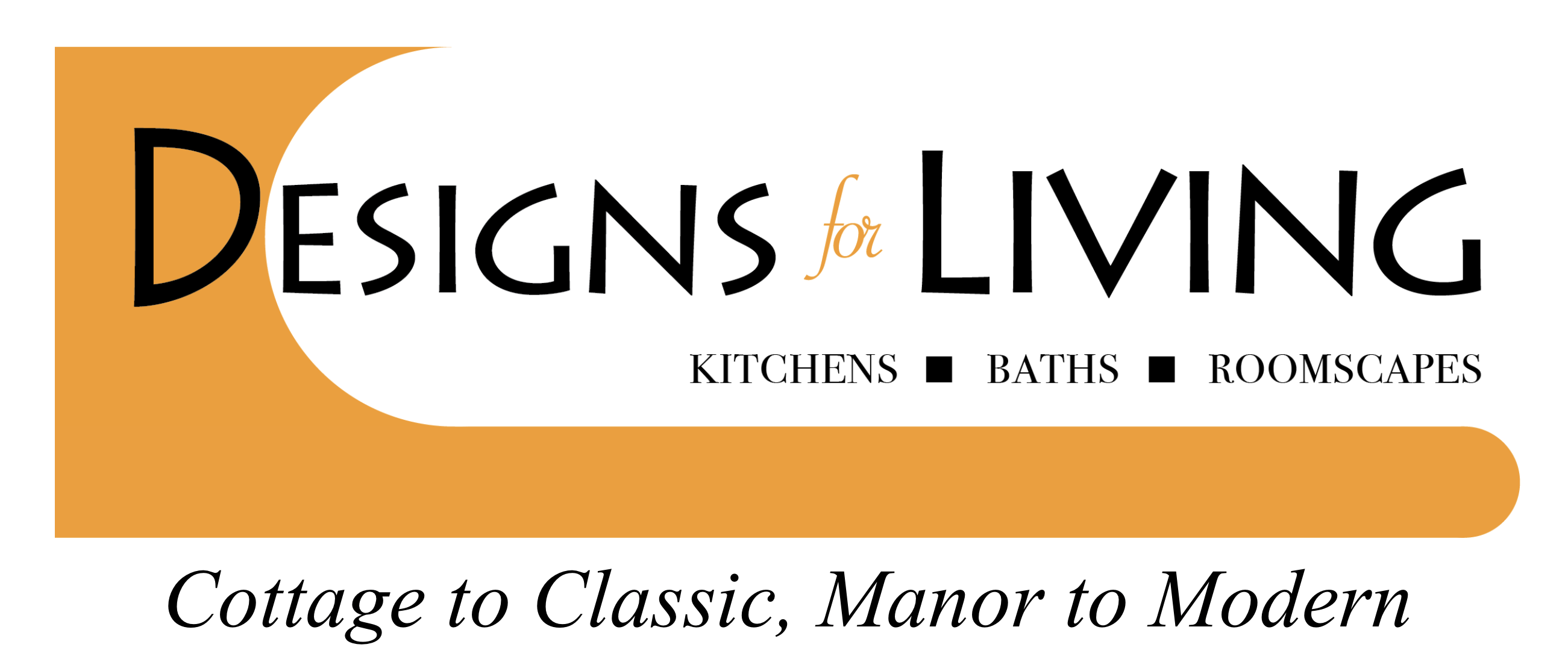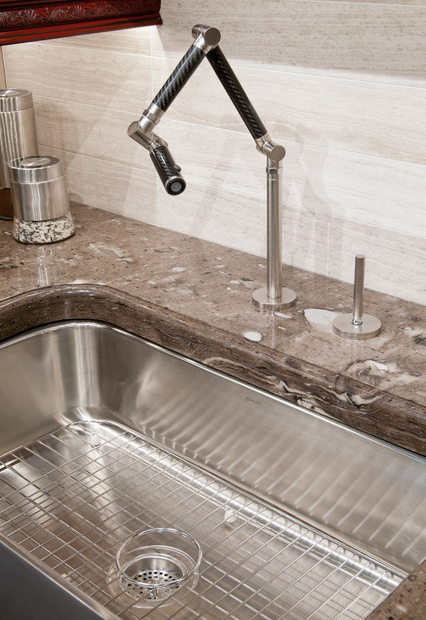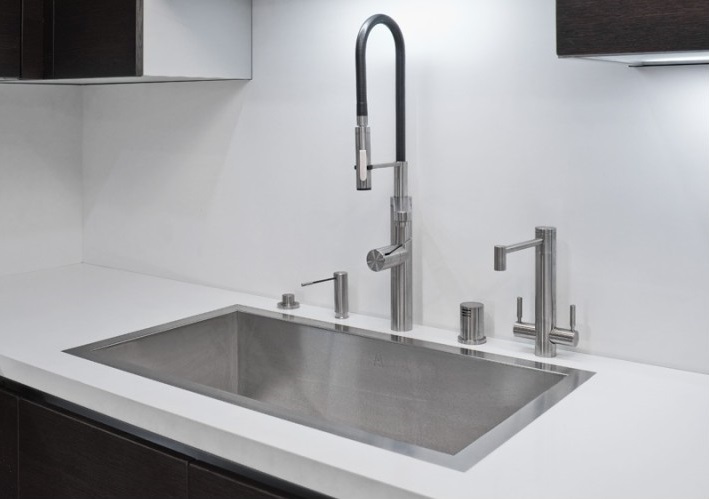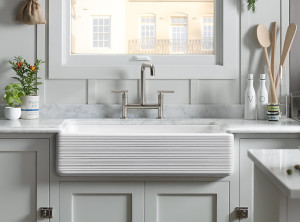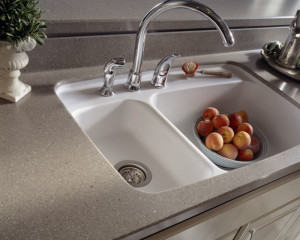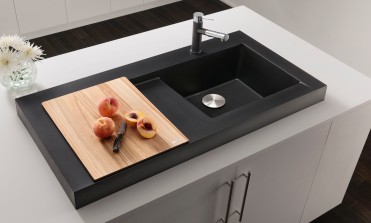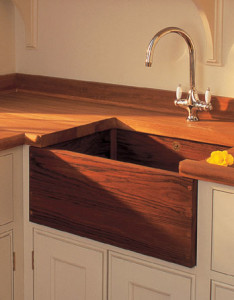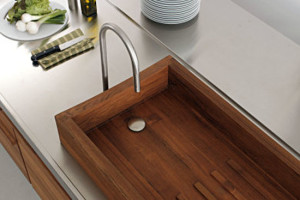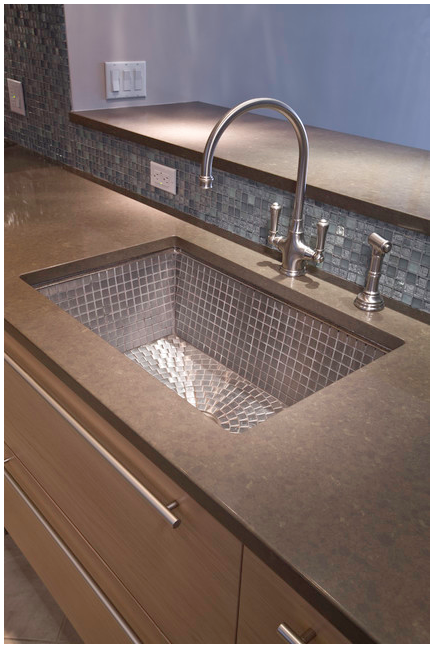In the Kitchen Kingdom, if the cooktop is King, then the sink is Queen!
In your living kitchen, there are 3 main fixtures, whether a 1 person or a multi cook kitchen with several overlapping or separate work areas. The center point of all activity is the sink – being the prep and clean up with counters both sides and forms the axis between food storage fixtures and the cooking appliances. Your sinks get the most use and the most abuse of all the fixtures! Thus they are made from mostly tough to indestructible materials – the most ancient of which are carved stone and metal, to the newest of which are of composite space age materials with stone particles in an acrylic resin.
METAL SINKS (Some of the Earliest Sinks)
- Copper, Bronze, Pewter, Cast Metals. Carved, Molded, Embossed – Old World to Modern, metal is one of the oldest man-formed materials. They can be either hard or soft and scratchable, non-toxic, and limitless in finish and design possibilities.
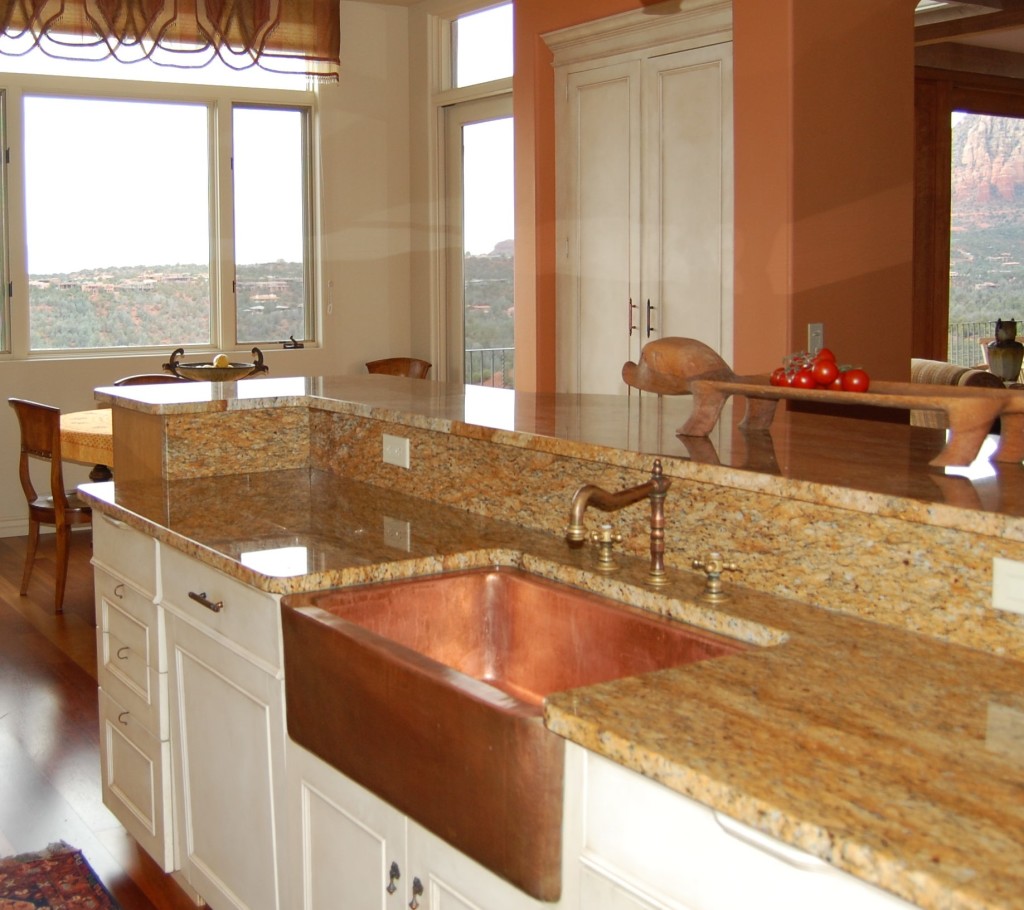
Antique copper undermounted in granite island counter. Go to www.designsforlivingvt.com to see project in Sedona.
See these company sites for more examples: Artisan Copper, German Silver, Hand Crafted Metal, Rocky Mountain Hardware, Mexican Copper, Native Trails.
- Stainless Steel – The most popular of sink materials – non-toxic, durable, non-denting, easy to clean with anything, the largest variety of stock configurations and sizes from under-mount, drop in, flush mount, apron and single and multiple bowl styles. Gauge (thickness), sound deadening, and metal proportions are important (nickel vs. cadmium for rust resistance and water spotting). The heavier the better – 16 vs 20 gauge, for example.
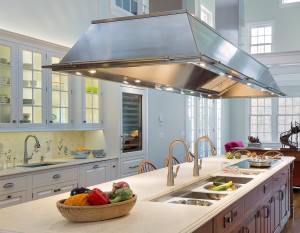
Two sinks: a huge 5′ Galley island prep sink and a large clean-up /secondary prep sink – both under-mounted. Click on the photo to see full project on my website. (SEE MY NEXT BLOG ABOUT THE GALLEY WORK STATION… MY FAVORITE NEW FIXTURE!)
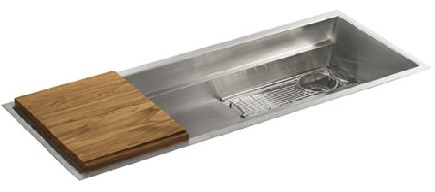
Kallista-Multiere by Mick De Giulio
See lots of choices at Elkay, Franke, Kallista, Kindred, The Galley, Mila-International.
ENAMELED CAST IRON SINKS This is high-fired to produce a beautiful, durable, and glossy finish; the cons are they are very heavy, will chip and stain, and show black marks from metal pots scraping the bottom. Available in old fashioned wall hung and farmhouse styles, they are offered in a wide range of single and double configurations with a multitude of colors including the most popular white. Perfect for traditional, classic, and cottage styles, the iron is often forged from reclaimed or sustainable sources. It is a long-lasting material, but do not use abrasive cleaners! See Kohler and American Standard among others.
NATURAL STONE SINKS Carved to any size desired out of a thick slab — and thus horrendously expensive — or the more affordable pieced stone, these sinks flow seamlessly with the countertop. The most commonly used soapstone and slate are nonporous, along with more unique stones such as granite and marble. Many natural stones can be formed into sinks that stand alone in their design importance.
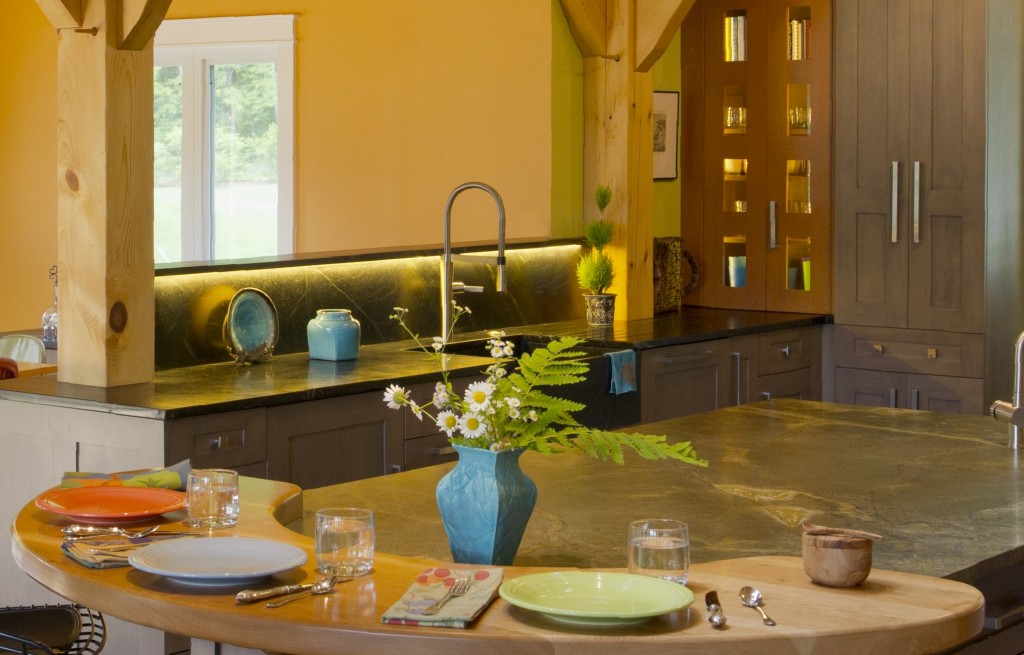
Soapstone clean-up apron sink under-mounted in soapstone countertop with drain grooves. Click on the image to see the complete project.
ENGINEERED STONE SINKS A limited number of formed sinks is available from Silestone. Quartz engineered stone slabs (such as Ceasarstone, LG, Cambria) can also be made to form custom sinks. Generally 99% non-porous and really scratch resistant, they are easy to maintain and no sealing is necessary.
SOLID SURFACE SINKS A man-made material usually composed of marble dust, bauxite, acrylic or polyester resins and pigments. Acrylic is less porous and harder, while polyester allows more intense colors but is softer. Many brands are a combination of both. Because the material is the same throughout, stains and chips are easily repairable with scotchbrite pads or sand paper. Smooth, soft feeling, easy on fragile dishware, and easy to maintain with normal and even abrasive cleaners.
A limited range of configurations and sizes is offered. Best use of these sinks is when used with a coordinating solid surface countertop, as in these photos. See Corian, Swanstone, Staron, Formica….
COMPOSITE SINKS These space-age materials make the most durable sinks.
- Granite composites are non-porous and scratch, chip, stain, and heat resistant (some to 280 degrees). They have a softer feel than enamel, steel, or stone.
- Quartz composites are a bit less durable and stain resistant. You have a wide choice of color, shape and bowl configuration. Cleaning requires only non-abrasive cleaners, sometimes vinegar solution for light stains and occasionally a bleach solution for heavy stains. Look at Blanco, Franke, Kraus, Elkay.
FIRECLAY SINKS These sinks emanate from France and Great Britain with their beginnings in the late 19th century. Fireclay is most lovingly used as a single bowl apron style ‘Farmhouse’ sink. The fireclay itself is a high-fire material producing a hard, durable, non-porous, chip- and stain-resistant sink with a finish as lusciously smooth and glossy as enamel that is easy to care for. Available mainly in classic white and off white, the Whitehaus Collection features a sapphire blue and black. With many embossed apron front designs, traditional designs, and tactile modern textures, these wonderful sinks can add a huge decorative focal point to your design. See Franke, Shaw’s Original, Blanco, Kohler.
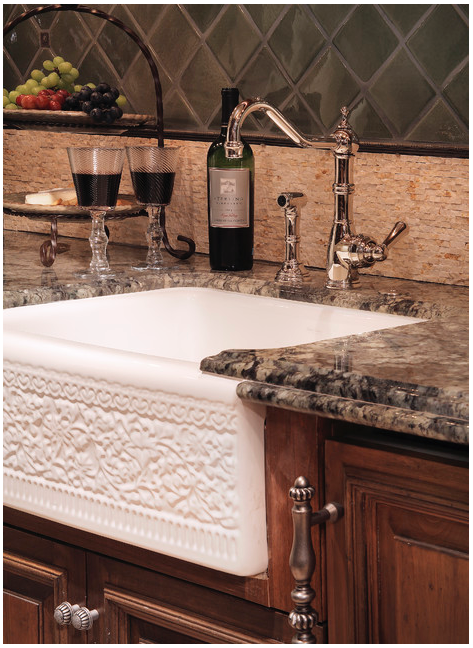
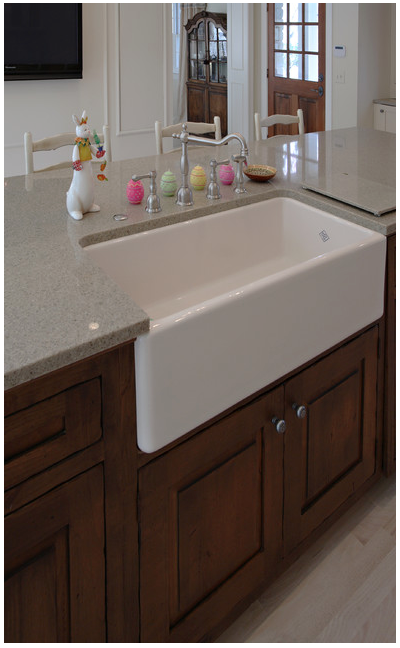
WOOD SINKS Perhaps the most unusual material for any sink, the beautiful look of wood is best shown off as an apron front sink. They are most often made with teak; also reclaimed and petrified woods are used along with sustainably grown or forested. Easy to maintain with mild cleaners, and naturally antiseptic, they can be a distinctive choice! Check out William Garvey sinks. Polymer-impregnated woods require no maintenance; for untreated wood, teak oil a few times a year is all that’s needed. Note that the wood sinks will darken with age.
CONCRETE Unfortunately, this material is not recommended for kitchens but should work well for a vanity. Concrete is indeed one of my personal favorite materials for its sensuous finish and exciting capability of shape, form, and color. It does require about the same sealing and maintenance as limestone or travertine (which I have in my own kitchen) and carries all the other attributes of natural stone, both postive and negative. Since these are cast products you can have sinks integrated with your tops in any size, shape, color, and visual textures you desire.
Specialized versions of this material have metal powders, added for their inherent colors and sheen, or incorporate recycled glass bits which offer unlimited design choices! See Native Trails, Stone Soup, See Sonoma Stone, Brooks Custom for concrete projects; and see the concrete countertop in my showroom’s working kitchen!
GLASS Nobody has come up with glass for kitchen sinks, only for the more gently-used vanity bowls, but there’s no reason one couldn’t be made!
OTHER Let your imagination soar! Here is a tile sink – in the same way I have designed Japanese soaking tubs.
